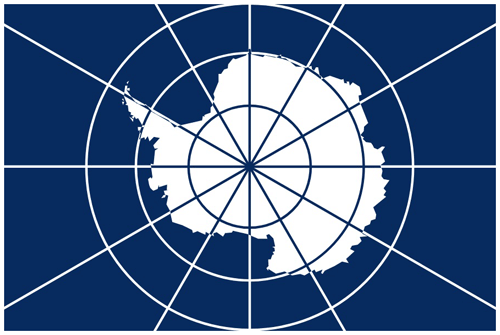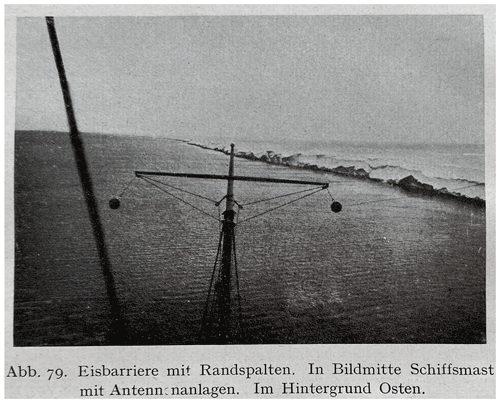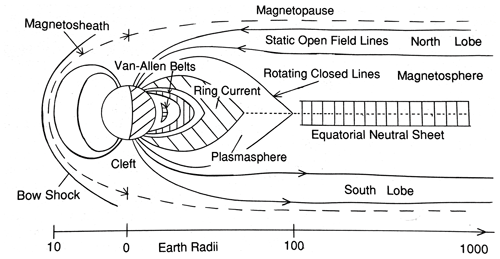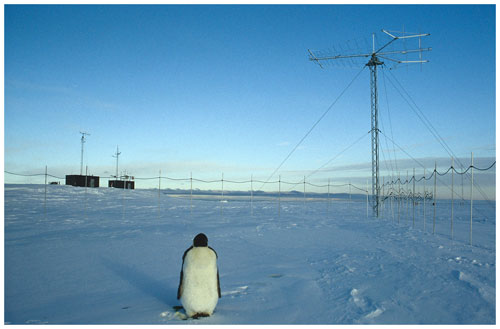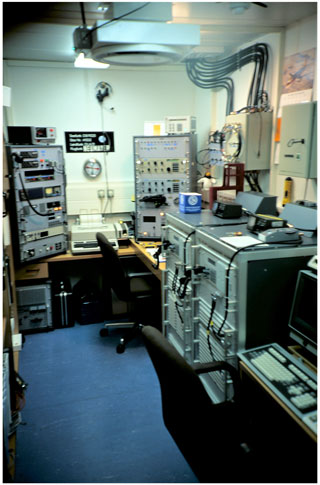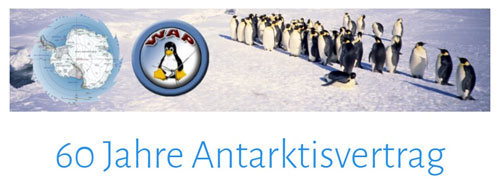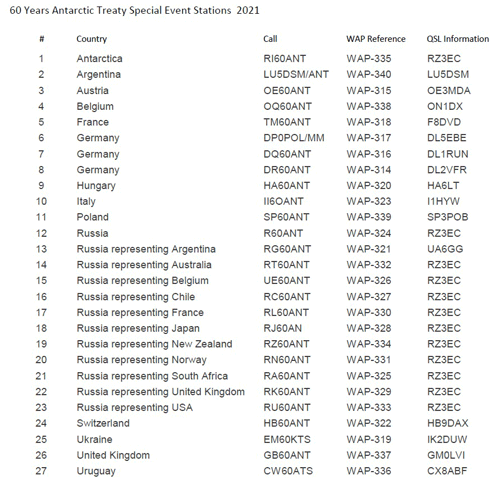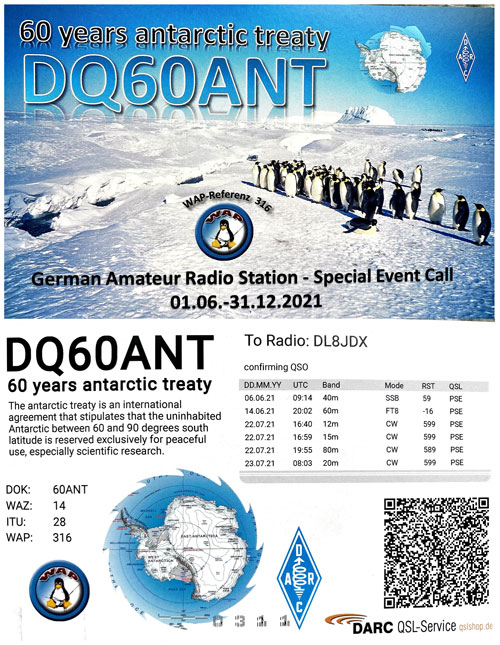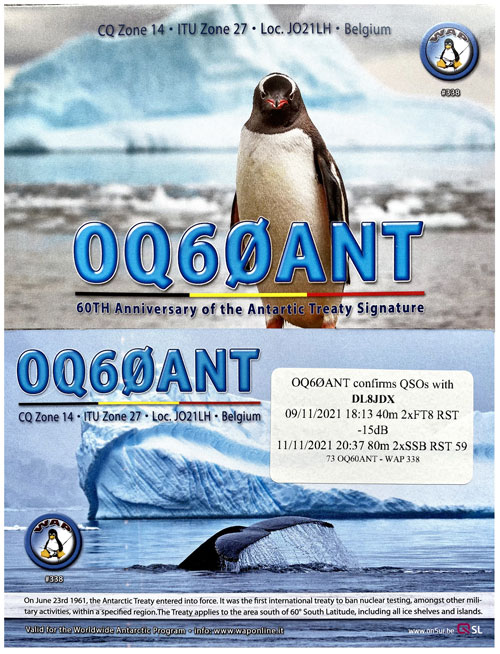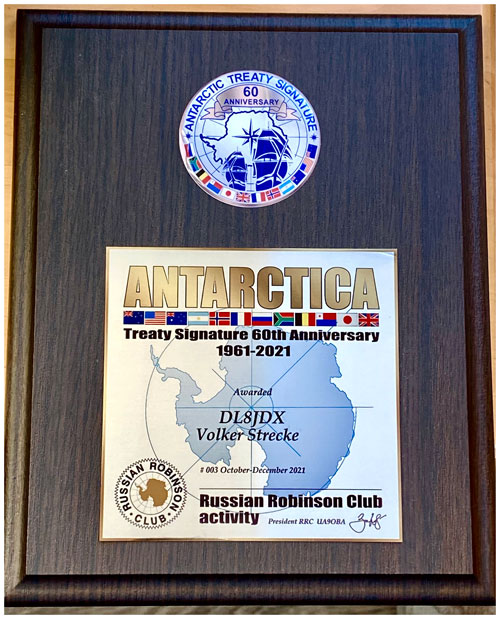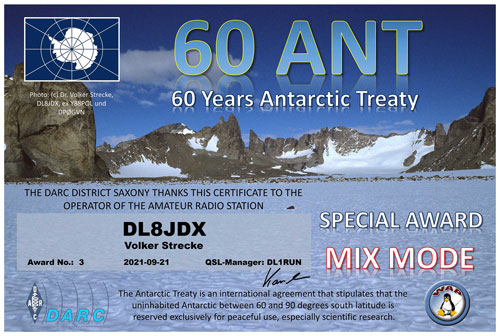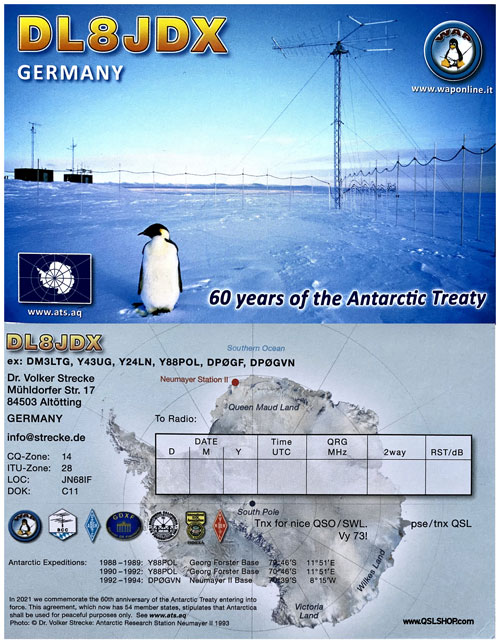the Creative Commons Attribution 4.0 License.
the Creative Commons Attribution 4.0 License.
60 years of the Antarctic Treaty – history and celebration in radio waves
Volker Strecke
The Antarctic Treaty, successfully negotiated and signed in 1959, entered into force after ratification by the 12 original signatory countries in 1961. Under the Antarctic Treaty, research activities are now carried out in Antarctica by 54 countries. These are 29 consultative and 25 non-consultative parties. Radio communications have always been an important part of all scientific activities in research stations, ships and aircraft in Antarctica. Historic expeditions in the 19th century and early 20th century had to use wired telegraph stations after returning from expeditions. Between 1911 and 1913, Wilhelm Filchner and Douglas Mawson were the first Antarctic expedition leaders to explore the possibilities of wireless telegraphy. Mawson succeeded in establishing radio communications from Antarctica to Australia for the first time in 1912. Today, the use of communication technologies is almost taken for granted. Direct amateur radio communications via shortwave are a flexible backup and an effective addition to communications about the Antarctic. On the occasion of the 60th anniversary of the Antarctic Treaty, a major international radio activity was launched in the second half of 2021 with which an important contribution to communication to the public was made. Amateur radio is now an important part of research activities in Antarctica.
Der multilaterale Antarktisvertrag, der 1959 erfolgreich verhandelt und unterzeichnet wurde, trat nach der Ratifizierung der 12 originären Unterzeichnerstaaten 1961 in Kraft. Im Rahmen des Antarktisvertrages werden heute Forschungsaktivitäten von 54 Staaten in der Antarktis durchgeführt. Dies sind 29 Konsultativ- und 25 Nicht-Konsultativmitglieder. Die Funkkommunikation war schon immer ein wichtiger Bestandteil sämtlicher wissenschaftlicher Aktivitäten in Forschungsstationen, Schiffen und Flugzeugen in der Antarktis. Historische Expeditionen im 19. Jahrhundert und zu Beginn des 20. Jahrhunderts mussten nach Rückkehr von den Expeditionsreisen drahtgebundene Telegrafenstationen benutzen. In den Jahren 1911 bis 1913 waren Wilhelm Filchner und Douglas Mawson die ersten Leiter von Antarktisexpeditionen, die die Möglichkeiten der drahtlosen Telegrafie erkundeten. Mawson gelang es 1912, erstmalig Funkverbindungen aus der Antarktis nach Australien herzustellen. Heute ist die Nutzung von Kommunikationstechnologien fast selbstverständlich. Direkte Amateurfunkverbindungen über Kurzwelle sind ein flexibel einsetzbares Backup und eine effektive Ergänzung in der Kommunikation über die Antarktis. Anlässlich des sechzigsten Jubiläums des Antarktisvertrages wurde im zweiten Halbjahr 2021 eine große internationale Funkaktivität ins Leben gerufen mit der ein wichtiger Beitrag zur Kommunikation an die Öffentlichkeit geleistet wurde. Amateurfunk ist heute ein wichtiger Bestandteil von Forschungsaktivitäten in der Antarktis.
- Article
(27563 KB) - Full-text XML
- BibTeX
- EndNote
The polar caps of our planet, the Arctic and also the Antarctic are of particular importance. On the one hand, they influence our climate, and on the other hand, they are strongly affected by climate changes. For many decades, Antarctica has been the subject of intensive research activities from an increasing number of nations.
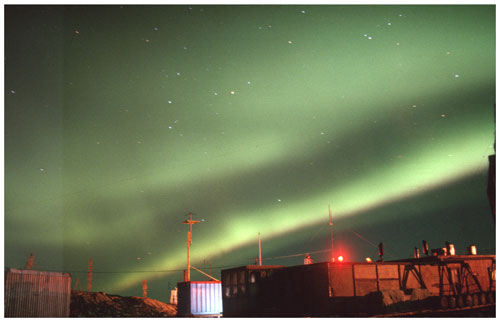
Figure 1The Georg Forster station with aurora australis in the background in polar night 1991 (Strecke, 2022).
The Antarctic Treaty System (ATS) from 1959 is a unique political agreement which promotes international cooperation between different countries and is the basis for all scientific activities in Antarctica today. This treaty was negotiated and signed on 1 December 1959 in Washington, DC, by 12 nations – Argentina, Australia, Belgium, Chile, France, Japan, New Zealand, Norway, South Africa, the Soviet Union, the United Kingdom, and the United States – following the International Geophysical Year (IGY) of 1957–1958 and entered into force on 23 June 1961 (ATS, 2022).
In 2021 international representatives from the Antarctic Treaty member states, scientists, politicians, Antarctic enthusiasts, and the global amateur radio community celebrated the 60th anniversary of the entry into force of the Antarctic Treaty and also 30 years of the Protocol on Environmental Protection, which belongs to the Antarctic Treaty System (ATS) and was signed in Madrid on 4 October 1991. This contract entered into force on 14 January 1998 after ratification by all Antarctic Treaty consultative parties (ATS, 2022).
All activities in Antarctica are subject to the premise of freedom of scientific research and international cooperation in Antarctica, as practiced during the IGY 1957–1958 and also the IGY years that have followed until today.
Today many Antarctic research stations from 54 ATS nations (29 consultative member states and 25 non-consultative parties) carry out scientific activities in Antarctica within the framework of the Antarctic Treaty System and are equipped with modern communication systems for real-time data exchange. Some stations, for example the British base Halley VIa and other stations, use a satellite-based radio station with Internet connection, LAN (local area network), VoIP (voice over IP), and Wi-Fi (wireless fidelity) network. It is therefore possible to even exchange emails or direct WhatsApp messages with Antarctica today.
Historic Antarctic expedition leaders at the beginning of the 20th century, such as Roald Amundsen, would not even have dreamed about these technological advances. Weeks after returning from his successful South Pole expedition in March 1912 Amundsen had to go to a telegraph station in Hobart, Australia, in order to inform the world about his achievements (Amundsen, 1912). These telegraph stations were connected with others through copper wires on land and in the sea. Interesting details about the encrypted telegram communication from Roald Amundsen to Norway were published in Srnka and Holloway (2016).
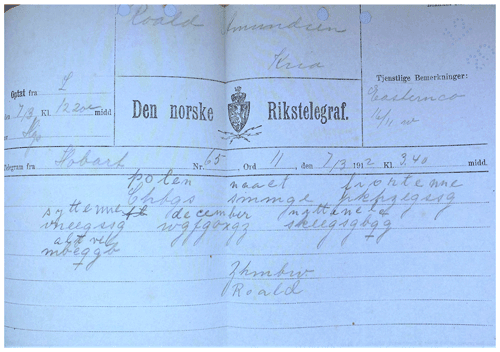
Figure 3One of the encrypted telegrams from Roald Amundsen on 7 March 1912 (Srnka and Holloway, 2016).
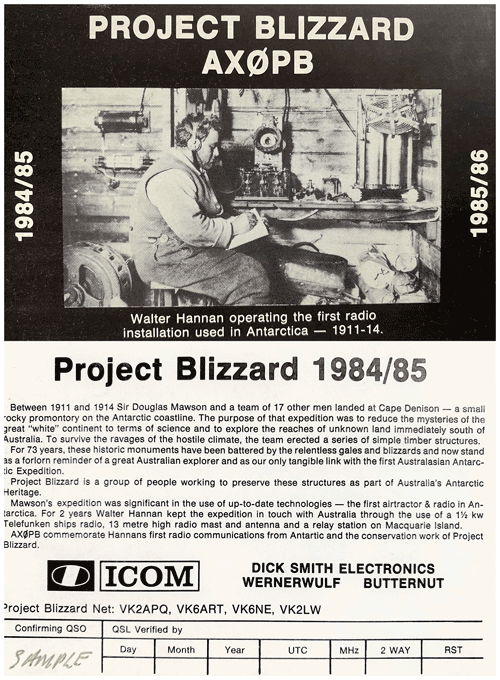
Figure 5Commemorative QSL card for the first radio communications from the Antarctic from Douglas Mawson's team in 1912. QSL cards are confirmations for successful radio contacts (Strecke, 2022).
Roald had agreed with his brother Leon Amundsen on a cipher method in which the letters in the words were swapped. Thus, the Norwegian word polen (the pole) was changed to CHBGS, naaet (reached) to SMMGE and “Roald” to ZHMBW.
The London newspaper The Daily Chronicle and the New York Times had bought the exclusive right as the highest bidders to be the first to report on the success of the expedition. Because of the copyrights, total secrecy was required until this first and all further telegrams with the expedition reports were decoded by Leon and transmitted to these newspapers, to King Haakon of Norway, and to the polar explorer Fridtjof Nansen, who provided the expedition ship Fram. The expedition reports were published by both newspapers on 8 and 9 March 1912 (Alamy Stock Photo, 2013) (Explorers Web, 2012) (Srnka and Holloway, 2016).
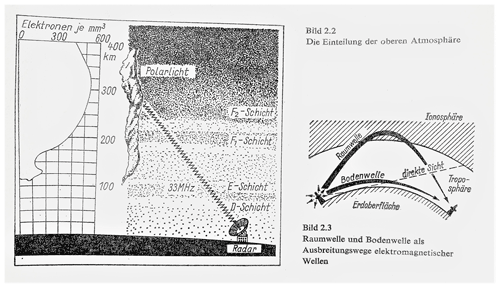
Figure 6The different ionospheric layers and ground wave and sky wave propagation (Rothammel, 1984).
Wilhelm Filchner and Douglas Mawson were the first Antarctic researchers to demonstrate the possibilities of wireless radio communications in the Antarctic.
During the second German Antarctic expedition in 1911–1912 with the ship Deutschland, the German explorer Filchner equipped his vessel with the newest technology at that time: a Siemens radio station provided by the Deutsche Betriebsgesellschaft für drahtlose Telegraphie mbH (Debeg), which was one of the main suppliers of maritime radio systems until the 1980s.
Filchner conducted detailed radio communications planning in cooperation with the Argentine Navy Ministry. The radio station on Isla Año Nuevo, part of the Tierra del Fuego archipelago, had been specially reinforced to support the German Filcher expedition and was intended to establish daily contact with the Deutschland at set times in order to exchange telegrams (Filchner, 1922).
With the radio station on the Deutschland, some radio communications with Buenos Aires and also with other ships that already had radio equipment on board were achieved during the voyage south in summer 1911. Unfortunately, later in 1911 and 1912, no radio contacts succeeded.
There are three possible reasons for this failure.
-
In order to establish radio connections successfully, the radio station needed not only an antenna on the masts of the ship but also grounding metal plates for a current connection with the salt water, because the Deutschland was a wooden ship. These metal plates were lost in stormy sea on the way between Buenos Aires and South Georgia.
-
The third officer of the Deutschland, Walter Slossarczyk, who was specially trained for the radio equipment, died by suicide on South Georgia on 26 November 1911 (Lüdecke, 2015). Therefore, an expert operation of the radio station was later only possible to a limited extent.
-
The years 1911 and 1912 were a phase of low solar activity (Solar Cycle 14) (BOM, 2022) and thus also of bad ionospheric reflection conditions. It was therefore more difficult to establish successful radio connections.
The Australian geologist Douglas Mawson left Hobart, Australia, with his expedition ship Aurora on 2 December 1911 and reached Macquarie Island on 11 December. He focused on building powerful radio stations on land (Mawson, 1915). The expedition team established radio stations on Macquarie Island and later at Cape Denison, East Antarctica, where the expedition after the exploration of the coastal areas overwintered in 1912 and 1913.
Because of heavy snow storms, it was very difficult to build and maintain the antenna masts at the main base at Cape Denison. The first messages were successfully sent to Australia with Macquarie Island as the relay station in April 1912. Later, messages were regularly exchanged with Australia. Occasionally even press news from Sydney could be received. At that time Morse telegraphy was the exclusive transmission mode used.
Thus, the expedition team of Douglas Mawson, especially his radio operator Walter Hannam, was the first to successfully establish wireless radio communications from the Antarctic continent (Mawson, 1915).
The year 1912 was turbulent. In April of that year Wilhelm Filchner's Deutschland froze in the icy Weddell Sea, Roald Amundsen successfully announced his conquest of the South Pole, Robert Scott froze to death in the ice, Douglas Mawson operated from Cape Denison, and the Titanic sunk in the North Atlantic. The Titanic had a radio system on board, and therefore help could be summoned and at least a small number of passengers and crew saved. The Titanic sinking prompted numerous measures to improve safety at sea. In 1914, the International Convention for the Safety of Life at Sea (SOLAS) (IMO, 2021) was adopted for this purpose. Among other things, it stipulated the establishment of an international ice warning service for the North Atlantic and agreement on 24 × 7 radio standby for ships with more than 50 persons on board.
From the beginning of the wireless telegraph era until the early 1920s the used radio frequencies were between 50 and 1500 kHz in the low-frequency (LF) and medium-frequency (MF) ranges. These are wavelengths between 6000 and 200 m (long and medium waves), according to the formula for wavelength: , where l is the wavelength (m), c is the speed of light (km s−1), and f is frequency (kilohertz).
The International Telecommunication Union defines LF between 30 and 300 kHz, MF between 300 kHz and 3 MHz, high frequency (HF) between 3 and 30 MHz (shortwave bands), and very high frequency (VHF) between 30 and 300 MHz. All these electromagnetic waves generally propagate in two methods: ground waves and sky waves (space waves).
Initially the most commonly used frequencies in maritime radio traffic were around 500 kHz (600 m wavelength). At these frequencies only the ground wave propagation can be used with some degree of certainty in most cases. For much of the 20th century 500 kHz was still one of the distress calling frequencies in marine radio. The reachable distance of ground waves is limited. Ground waves follow the curved surface of the Earth and propagate quasi-optically depending on the frequency and the conductivity of the surface. Above the sea the range of the ground wave is greater than above the ground because of the greater specific conductivity of the seawater. With increasing frequency, the penetration depth of the electromagnetic field into the ground decreases, and ground waves of shorter wavelengths or higher frequencies are thus strongly attenuated.
With high-power transmitters and large antenna systems, distances of up to about 1500 km could be bridged with ground waves in the long- and medium-wavelength ranges. Therefore in 1911, relay stations operating on frequencies around 500 kHz were established on New Year's Island (Filchner, 1922) or Macquarie Island (Mawson, 1915) to close the range gap from Antarctica to the homelands.
Because of the increasing attenuation and thus reduction in range, higher frequencies or short waves generally were considered useless at that time. Radio amateurs discovered through their experiments that radio waves of higher frequencies in the HF range could indeed bridge distances of several thousand kilometers (ITU News, 2020). The second type of propagation was used: sky wave reflection at the ionosphere.
In the upper atmosphere at an altitude of about 100 to 500 km from the Earth's surface, there are reflective layers that are ionized by solar radiation and thus made electrically conductive.
Radio wave reflections from the ionosphere can be highly impacted by the space weather. The sun emits electromagnetic radiation in wavelengths from meters to nanometers (radio, microwaves, infrared, visible light, ultraviolet, X-ray and beyond) as well as corpuscular emissions. This particle radiation is called plasma stream or solar wind. Both types of radiation create varying values of ionization during day and night at different layers of the ionosphere and influence the magnetic field of the Earth as well as the ionospheric reflection behavior.
Stronger solar radiation, especially during coronal mass ejections (CMEs), is often accompanied by plasma streams of high-energy charged corpuscular particles (electrons and protons). These particles enter the upper atmosphere in the regions of the magnetic poles at the cleft where the field lines of the Earth's magnetic field meet the surface (Newton, 1991).
As a result, auroral phenomena and strong ionizations of lower ionospheric layers occur, which can attenuate or even completely absorb the radio waves that are normally reflected from higher layers. This phenomenon is called polar cap absorption (PCA). Therefore, HF radio links in polar regions are often very unreliable and unstable. High-energy solar radiation outbreaks can also disturb satellite infrastructures and can even cause shutdowns of electric energy grids by high induction currents on the lines.
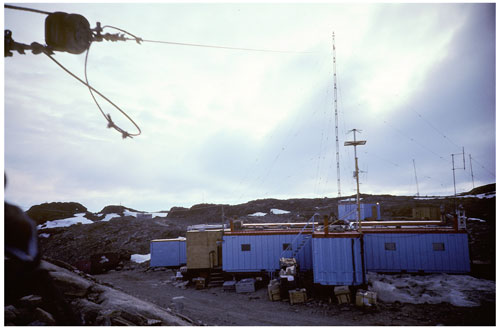
Figure 8Antennas at Georg Forster Station 1991: V-beam with two 85 m long wire legs and a corner reflector (Strecke, 2022).
In conclusion it can be stated that the HF sky wave reflection properties of the different ionospheric layers depend on the degree of ionization (depending on the solar activity), on daytime and nighttime variations in the attenuation values, and on the frequency and incidence angle of the radio waves.
Beginning in the 1920s, long-range radio communications gradually began to use a broader spectrum of higher frequencies in the HF range (3 to 30 MHz). In this frequency range longer distances can be bridged with short waves using sky wave reflections at the ionosphere and even with lower transmission powers.
Later Antarctic expeditions were able to benefit from the experiences of the expeditions of Filchner and Mawson. Instead of long and medium waves, short waves proved to be more suitable for long-distance connections. Since the beginning of the 1920s, fixed and mobile radio stations have been able to bridge greater distances using shorter wavelengths in the HF spectrum. Sky wave propagation with effective transmitting and receiving equipment and directional antennas with optimized radiation angles were the tools of choice.
For example, the US Antarctic expeditions of Richard Evelyn Byrd between 1928 and 1940 and the third German Antarctic expedition of Alfred Ritscher from 1938 to 1939 already used comprehensive HF radio systems for communications between ships, aircraft, and shore stations as well as for direct message transmission back home without intermediate stations (Lüdecke, 2012).
Beginning in the 1950s, radio communications to and from Antarctic stations used not only Morse telegraphy but also voice radio (telephony with amplitude modulation) and RTTY (radio teletype with frequency shift keying). Later in the 1950s a more effective telephony transmission mode was introduced: the single-sideband (SSB) modulation. In the 1980s, newer radio teletype transmission modes, such as FEC (forward error correction) or SITOR (Simplex Teletype Over Radio) with ARQ (automatic repeat request of data packets), were used for telex traffic. These newer modes were suitable to achieve reliable data transmissions over unreliable HF communication channels. Radio communications for voice, fax, and telex via geostationary and orbiting satellites that provided higher quality and stability were also added in the 1980s.
The whole system of geophysical interactions between the magnetic fields of the sun and the Earth, the emitted waves and particles, and the resulting various states of the ionospheric layers is even more complex. For example, within the framework of international magnetosphere studies, ionospheric research programs were carried out at the base laboratory of the German Democratic Republic and the later Georg Forster Station between 1976 and 1992 (Voigtländer, 1981; Grafe, 1989; Wagner and Strecke, 1990).
Also, other Antarctic stations such as Halley or Casey are executing scientific space weather programs (BAS, 2022; AAT, 2022). These studies are very important not only for HF radio links but also for maintaining the stability of satellite-based services, such as telecommunication or navigation systems (GRAPE, 2020).
Still today the topic of communication, especially the thorough maintenance of radio links via HF and satellites, is of particular importance in all research activities in the Antarctic. Because satellite links can be switched off, interfered with, or attacked, HF radio links are still very important.
Today the Global Maritime Distress and Safety System (GMDSS) developed by the International Maritime Organization (IMO) and part of the SOLAS convention (IMO, 2021) is broadly used for all maritime emergency and rescue operations. The GMDSS consists of several modular components in the HF, VHF, and satellite frequency spectrum (IMO, 2021). In today's Antarctic expeditions ships, airplanes, helicopters, vehicles, research stations, and summer camps are equipped with modern radio systems and satellite phones (for example Iridium for voice, messaging, and data services) in order to remain connected and safe. Through these vital connections, research results, measured values, protocols, and many other data and information are transmitted daily to the respective countries and also between other research stations.
In addition, amateur radio (also called HAM radio) often is used as a communication backup, and it also contributes to a transfer of knowledge about Antarctic research activities to the public in an effective way. Engaged amateur radio operators actively developed and utilized new digital communication modes and frequencies in the radio spectrum – historically and today (Kuhl, 1992; ITU News, 2020; Hartje, 2020).
The flexibility of amateur radio connections has even made it possible for expedition members to be rescued in several emergency operations. During his overwintering stays in the Antarctic, the author of this article was himself actively involved in such search and rescue activities (Strecke, 2009).
The Mittweida University of Applied Sciences, where the author Volker Strecke studied and completed his doctorate, has a special relationship with Antarctica. From the amateur radio club station DK0MIT (former call signs Y32ZN and DM3EN), many interesting connections to research stations on the southern ice continent were made, starting in the early 1980s (DK0MIT Amateurfunk-Klubstation, 2014). This club also supported the activities of the author while he was working as a communications electronics technician in Antarctica.
These were the three radio activity periods of the author from the Antarctic:
-
23 March 1988–15 February 1989, Georg Forster Station, land-based radio call Y3G, maritime radio call Y3ZA, and amateur radio call Y88POL;
-
12 November 1990–5 March 1992, Georg Forster Station, land-based radio call Y3G, maritime radio call Y3ZA, and amateur radio call Y88POL;
-
20 December 1992–23 February 1994, Neumayer II Station, land-based radio call DLA21, maritime radio call DB9020, and amateur radio call DP0GVN.
During these three activities, regular radio connections to Germany via maritime coastal stations, to other Antarctic research stations, and to other ships and airplanes were established in order to exchange scientific data, weather reports, personal messages, or emergency traffic. Also, amateur radio connections (QSO) from the Mittweida club station DK0MIT to Volker Strecke in Antarctica were used in order to exchange messages (for example radio contact data for later QSL confirmations) and greetings.
Today many Antarctic research stations, such as the German Neumayer III (Gernandt, 2006), the British Halley VIa, the Brasilian Comandante Ferraz, the US Amundsen-Scott South Pole stations, or the Jang Bobo station from South Korea, are modern buildings with longer lifetimes and sustainable infrastructure. Sophisticated communication systems for geostationary and orbiting satellites enable direct network connections to their home countries.
HF links are used for communication traffic with other research stations, field bases, ships, airplanes, and amateur radio connections to the rest of the world. A special feature is the use of the Qatar-OSCAR-100 (QO-100) (Es'hail-2) geostationary satellite for amateur radio at the club station DP0GVN from the Neumayer III station (AMSAT-DL, 2021). With this new satellite-based amateur radio facility, information sessions are held at regular intervals with school classes in order to communicate goals and topics of research and life in Antarctica (AMSAT-DL, 2021).
In the year 2021 this radio club DK0MIT, in close cooperation with the organizer of the Worldwide Antarctic Program WAP, Giovanni Varetto I1HYW (WAP, 2021) and with the author Volker Strecke DL8JDX, organized an international radio activity (DQ60ANT, 2021). A simple idea has become a global event.
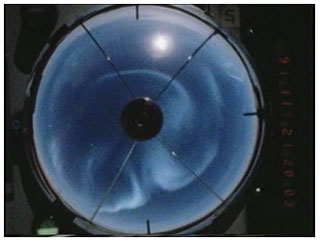
Figure 18Photo recording from an Aurora all-sky camera at Georg Forster Station in 1991 (Strecke, 2022).
In the second half of 2021 this international amateur radio activity was launched in order to commemorate the 60th anniversary of the entry into force of the Antarctic Treaty System. Radio amateurs worldwide took to the airwaves in celebration of this anniversary.
A total of 27 special event radio stations from 13 different countries participated in this event.
The three German special call signs DP0POL/mm, DR60ANT, and DQ60ANT were part of this activity as well.
-
D P 0 P O L / mm – Worldwide Antarctic Program (WAP) reference WAP-317.
This station operates from the German research icebreaker Polarstern and was active during the voyage in the Antarctic in spare time when the communication duties allowed.
See http://www.qrz.com/db/dp0pol/mm (last access: 5 July 2022).
-
D R 6 0 A N T – WAP reference WAP-314.
This station was organized by the team Special Event Stations (SES) from the Deutsche Amateur Radio Club (DARC), led by Enrico Stumpf-Siering, DL2VFR.
See http://www.qrz.com/db/dr60ant (last access: 5 July 2022).
-
D Q 6 0 A N T – WAP reference WAP-316.
This station was organized by a team from the radio club DK0MIT at the University of Applied Sciences in Mittweida in southern Germany, led by Karsten Stephan, DL1RUN.
See http://www.qrz.com/db/dq60ant (last access: 5 July 2022).
All special event stations were active on all amateur radio shortwave bands and amateur radio satellite channels between 1 June and 31 December 2021.
From all special event stations many thousands of radio contacts (QSO) were made to all over the world. Each single contact was one word more in communicating about the Antarctic Treaty. The objectives of the Antarctic Treaty are to preserve the ecological balance on all the land and ice shelves south of 60∘ S latitude, to use the Antarctic only for peaceful purposes, and to promote scientific research and international cooperation. Military exercises and operations as well as the extraction of mineral resources are therefore prohibited. In amateur radio connections between stations from Antarctica, special event stations, and stations from many different countries, which were characterized by great interest, these goals were actively promoted (DQ60ANT, 2021).
Example amateur radio messages were “This is Delta Queen Six Zero Alpha November Tango (DQ60ANT). We are a special event station on the occasion of the sixties anniversary of the Antarctic Treaty entering into force. The Antarctic continent is a special subject of peaceful exploration and cooperation under the direction of this important agreement.” or “This is Delta Radio Six Zero Alpha November Tango (DR60ANT). We are active because we celebrate 60 years Antarctic Treaty in this year 2021. This treaty regulates the exclusively peaceful use of Antarctica. Through amateur radio connections we also propagate the international cooperation.”
Similar messages were also displayed on the confirmation cards (QSL cards) from various special event stations as well as on their respective websites (DQ60ANT, 2021).
Text on a QSL card reads (Fig. 14) “The Antarctic Treaty is an international agreement that stipulates that the uninhabited Antarctic between 60 and 90 degrees south latitude is reserved exclusively for peaceful use, especially scientific research.”
Text on a QSL card reads (Fig. 15) “On June 23rd 1961, the Antarctic Treaty entered into force. It was the first international treaty to ban nuclear testing amongst other military activities, within a specified region. The Treaty applies to the area of 60∘ South Latitude, including all ice shelves and islands.”
Special 60 ANT awards, which could be achieved for a certain number of contacts, even increased the attractiveness of this global activity.
Radio contacts from the polar areas are always a challenge. As mentioned above, changing space weather conditions, i.e., activities from the sun, can influence them in various ways. X-rays and the ejection of particles from the sun, such as solar wind or coronal mass ejection (CME) events, are responsible for the ionospheric HF propagation, and even satellite links can massively be distorted. CMEs can also cause geomagnetic storms, radio auroras, and southern polar lights (aurora australis) (Janda, 1986; Wagner and Strecke, 1990; Newton, 1991; Space Weather News, 2022).
The magnetic measurement and photographic documentation of aurora australis was one of the scientific programs at the German Georg Forster station in the Antarctic during winter 1991. For example, we studied the interaction between the Earth's magnetic field variations, the aurora, and the attenuation state of the ionosphere with a riometer-based cosmic noise absorption (CNA) measurement (Voigtländer, 1981).
Amateur radio operators worldwide demonstrated successfully that they can establish links between Antarctica and their home countries on HF shortwave bands (Kaatz, 2014; Flick and Bromirski, 2019; Marinaro, 2014). For example, in the Antarctic summer seasons 2020/2021 and 2021/2022 radio contacts (QSO) with DP1POL Neumayer III, DP0POL/MM Polarstern, VP8/SQ1SGB Halley VIa, LU1ZG Belgrano II, 8J1RL Syowa, ZS7ANF Wolfs Fang Runway, and DT8A King Sejong were made by many amateur radio stations from Germany as well as by the author Volker Strecke DL8JDX from his home-based radio station. The American stations KC4USV from McMurdo and KC4AAA from the Amundsen-Scott South Pole station were active too and could be reached by other amateur radio stations. Exclusive confirmation cards, called QSL, from Antarctic stations or from the abovementioned special event stations are always a sought-after collector's item.
In case commercial satellite-based radio systems, which always require an appropriately functioning infrastructure, should fail, amateur radio shortwave links are always available as a backup. These links are direct from point to point, are free of charge, and require nothing in between, just the radio stations and antennas as well as favorable space weather conditions. This has been proven in practice many times. Amateur radio is not only an exciting hobby but meanwhile an important contribution to the success of Antarctic expeditions.
Radio communication has always been an important part of all research activities in the Antarctic. Internationally, amateur radio messaging of the goals of the Antarctic Treaty also contributes to increasing the attractiveness and intensifying the communication about the important research activities on the southern ice continent.
On the occasion of the 60th anniversary of the Antarctic Treaty entering into force, it is important to reaffirm that it is in the interest of all humankind that Antarctica continue to be used exclusively for peaceful purposes (ATS, 2022). Amateur radio activities are an effective way of promoting this message and contributing to international cooperation in Antarctica in the global context of the protection of our climate.
Text on a QSL card reads (Fig. 19) “In 2021 we commemorate the 60th anniversary of the Antarctic Treaty entering into force. This agreement, which now has 54 member states, stipulates that Antarctica shall be used for peaceful purposes only. See http://www.ats.aq (last access: 5 July 2022)”.
All used information is publicly available. See all references mentioned further below.
The author has declared that there are no competing interests.
Volker Strecke, Communications electronics technician and member of three overwintering expeditions:
-
1988–1989 Georg Forster Base Y3G Y3ZA Y88POL
-
1990–1992 Georg Forster Base Y3G Y3ZA Y88POL
-
1992–1994 Neumayer II Base DLA21 DB9020 DP0GVN
Publisher’s note: Copernicus Publications remains neutral with regard to jurisdictional claims in published maps and institutional affiliations.
In particular, I would like to thank Cornelia Lüdecke, Bernhard Diekmann, and Donovan Dennis for their many valuable tips and advice in shaping this article. I would also like to thank the Special Event radio station teams from 13 different countries for their activities during the 60th anniversary year of the Antarctic Treaty in 2021. I also in particular acknowledge Giovanni Varetto, I1HYW, for coordinating all these activities within the Worldwide Antarctic Program.
This paper was edited by Donovan Dennis and reviewed by Johanna Grabow.
Alamy Stock Photo: 1912 Daily Chronicle half front page reporting Captain Amundsen discovers the South Pole, https://www.alamy.com/stock-photo-1912-daily-chronicle-half-front-page-reporting-captain-amudsen-discovers-72279200.html (last access: 5 July 2022), 2013.
AMSAT-DL: New QO-100 satellite antenna for DP0GVN, https://amsat-dl.org/en/new-qo-100-satellite-antenna-for-dp0gvn/ (last access: 5 July 2022), 2021.
Amundsen, R.: Die Eroberung des Südpols, Die norwegische Südpolfahrt mit dem Fram 1910–1912, Verlag für die Schweiz: Buchhandlung Georg Sommerfeld, Bern, 1912.
Antarctic Treaty System (ATS): Secretariat of the Antarctic Treaty, Tools and Resources, http://www.ats.aq (last access: 5 July 2022), 2022.
Australian Antarctic Program (AAT): Scientific Observatories throughout the Australian Antarctic Territory: https://www.antarctica.gov.au/science/technology-innovation/antarctic-observatories/ (last access: 5 July 2022), 2022.
British Antarctic Survey (BAS): SuperDARN – Super Dual Auroral Radar Network at Halley Base, https://www.bas.ac.uk/polar-operations/sites-and-facilities/facility/halley/radars/ (last access: 5 July 2022), 2022.
Bureau of Meteorology of the Australian Government (BOM): Graphs of Historical Solar Cycles, Solar Cycle 14, https://www.sws.bom.gov.au/Educational/2/3/1 (last access: 5 July 2022), 2022.
DK0MIT Amateurfunk-Klubstation: Weltweit verbunden, http://www.hs-mittweida.de/newsampservice/hsmw-news/pressearchiv/detailansicht-pressearchiv/aktuell/3735/ (last access: 5 July 2022), 2014.
DQ60ANT: 60 Years Antarctic Treaty activity, http://www.60ant.de (last access: 5 July 2022), 2021.
Explorers Web: Hundred years ago: Amundsen breaking news, https://explorersweb.com/polar/news.php?id=20676 (last access: 5 July 2022), 2012.
Filchner, W.: Zum sechsten Erdteil, Die zweite deutsche Südpol-Expedition 1911–1912, Ullstein Berlin, 1922.
Flick K6REF, R. and Bromirski, P. D.: Amateur Radio from Antarctica, QST, ISSN 0033-4812, Published monthly as its official journal by the American Radio Relay League, Inc., Feb. 2019 Issue, 65–67, 2019.
Gernandt, H., El Naggar, S., Janneck, J., Matz, T., and Drücker, C.: From Georg Forster Station to Neumayer III – a Sustainable Replacement at Atka Bay for Future, Polarforschung, 76, 59–85, https://doi.org/10.2312, 2006.
Grafe, A.: Energiereservoir Magnetosphäre, Zeitschrift Wissenschaft und Fortschritt, DDR, 39, 158–161, 1989.
GRAPE: GNSS (Global Navigation Satellite Systems) Research and Application for Polar Environment, http://www.grape.scar.org/ (last access: 5 July 2022), 2020.
Hartje DK5HH, M.: Erste Ergebnisse der Ausbreitungsversuche in der Antarktis mit WSPR und FT8, Vortrag, Amateurfunktagung, München, 1. März 2020, Konferenz des Deutschen Amateur Radio Clubs (DARC) und der Hochschule München, https://www.hm.edu/allgemein/aktuelles/veranstaltungen/veranstaltungsdetail_181696.de.html (last access: 5 July 2022), 2020.
International Maritime Organization (IMO): History of SOLAS, https://www.imo.org/en/KnowledgeCentre/ConferencesMeetings/Pages/SOLAS.aspx (last access: 5 July 2022), 2021.
ITU News: International Telecommunication Union (ITU), Why World Amateur Radio Day is key to highlight crucial services, https://news.itu.int/why-world-amateur-radio-day-is-key-to-highlight-crucial-services-timothy-ellam/ (last access: 5 July 2022), 2020.
Janda OK1HH, F.: Vom Sonnenwind zum Polarlicht, Funkamateur, Magazin für Amateurfunk, Elektronik, Funktechnik, 9-1986, 10-1986, 11-1986, 1986.
Kaatz K8SDK, S.: A Maritime Mobile DXpedition in Antarctica, QST (ISSN 0033-4812), Published monthly as its official journal by the American Radio Relay League, Inc., March 2014 Issue, http://www.arrl.org/files/file/QST/This%20Month%20in%20QST/March%202014/Kaatz.pdf (last access: 5 July 2022), 2014.
Kuhl DL1AX, H.: Funk-Kommunikation in der Antarktis, Kurzwelle hören, 24-3, 1992.
Lüdecke, C.: Investigation of the unknown: the flight programme of the German Schwabenland expedition 1938/39, The Polar Journal 2, 312–333, https://doi.org/10.1080/2154896X.2012.735042, 2012.
Lüdecke, C.: Deutsche in der Antarktis – Expeditionen und Forschungen vom Kaiserreich bis heute, Ch. Links Verlag, Berlin, ISBN 978-3-86153-825-7, 2015.
Marinaro WN1M, M.: Polar Exploration, Polar Exploration, QST (ISSN 0033-4812), Published monthly as its official journal by the American Radio Relay League, Inc., June 2014, 63–65, 2014.
Mawson, D.: The Home of the Blizzards, Being the Story of the Australasian Antarctic Expedition, 1911–1914, William Heinemann, London, 1915.
Newton G2FKZ, C.: Radio Auroras, Radio Auroras, Radio Society of Great Britain (RSGB), ISBN 1-872309-03-8, 1991.
Rothammel Y21BK, K.: Antennenbuch, Militärverlag Berlin, 745-588-4, 1984.
Space Weather News: What's up in space, http://www.spaceweather.com, last access: 5 July 2022.
Srnka, M. and Holloway, T.: South Pole – A double opera in two parts, Composer Miroslav Srnka, Libretto by Tom Holloway, Bayerische Staatsoper, Programmbuch zur Uraufführung am 31. Januar 2016 im Nationaltheater München, https://www.staatsoper.de/stuecke/south-pole (last access: 5 July 2022), 2016.
Strecke DL8JDX, V.: DR09ANT – Das Sonderrufzeichen engagiert sich für die Antarktisforschung, Rettungsaktion in der Antarktis, C18 Mitteilungen, Nr.126, 2009.
Strecke DL8JDX, V.: Private Photo Archive, Recorded during three Antarctic expeditions between 1988 and 1994, 2022.
Voigtländer, J.: Meßaufbau für die Registrierung der kosmischen Radiostrahlung, Zeitschrift Radio Fernsehen Elektronik, 30, 2, 1981.
Wagner, S. and Strecke, V.: Effective Offline-Processing of complex geomagnetic and ionospheric data, Geodätische und geophysikalische Veröffentlichungen, Reihe 1, S. 193–205, Berlin, 1990.
Worldwide Antarctic Program (WAP): 60 ATS Anniversary Event, http://www.waponline.it/6oats-anniversary/ (last access: 5 July 2022), 2021.
- Abstract
- Kurzfassung
- Introduction
- History of Antarctic radio communication
- Antarctic radio communication today
- Antarctic overwintering expeditions by Volker Strecke
- Global amateur radio activity after 60 years of the Antarctic Treaty
- Summary
- Data availability
- Competing interests
- Author contributions
- Disclaimer
- Acknowledgements
- Review statement
- References
- Abstract
- Kurzfassung
- Introduction
- History of Antarctic radio communication
- Antarctic radio communication today
- Antarctic overwintering expeditions by Volker Strecke
- Global amateur radio activity after 60 years of the Antarctic Treaty
- Summary
- Data availability
- Competing interests
- Author contributions
- Disclaimer
- Acknowledgements
- Review statement
- References






